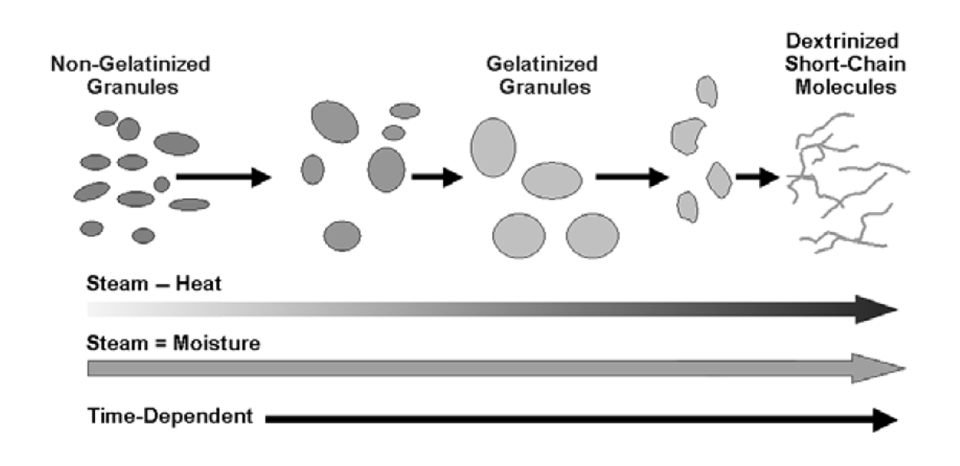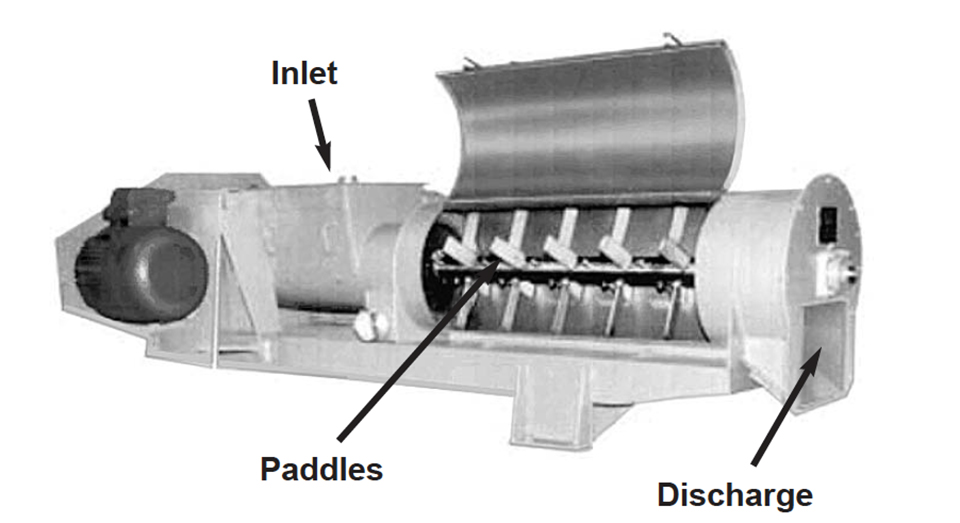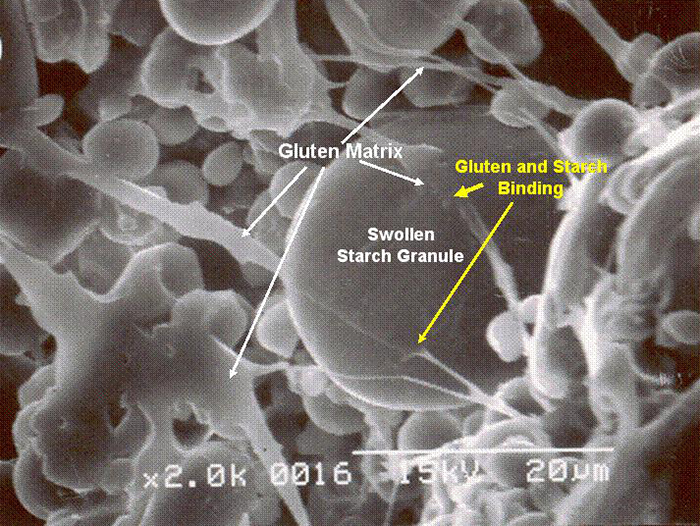Principles of steam conditioning
The success of shrimp feed manufacturing depends not only on the nutritional quality of the formulation but also on the water stability of the pelleted feed. Even today, with new advances in processing technology, pelleting continues to be the most popular and economical method of producing crustacean feeds. To obtain highly water stable pelleted feeds, it is recommended that the mash be preconditioned for more than 90 seconds at temperatures higher than 90 degrees-C. Longer residence time in the conditioner permits more penetration of the moisture and better distribution of heat to increase starch gelatinization, which results in better binding of the feed particles, hence increasing water stability.
Starch gelatinization
The term gelatinization has been widely used in connection with the pelleting process, and more so in relation to the production of high-quality, water-stable pellets. Starch gelatinization is defined as the loss of birefringence, or as the irreversible rupture of the native secondary bonds in the crystalline region of the starch granule. According to Hoseney (1986), the loss of birefringence occurs under continuous heating and excess moisture, which can lead to increased viscosity and increased swelling (water uptake) of the starch granules. The process of starch gelatinization in the preconditioner is shown in Fig. 1.

Starch damage
Regarding gelatinization, starch damage occurs during grinding as well as in the pelleting process. During pelleting, damage is mainly caused by friction as the mash is compressed and extruded through the working area of the die, and has been well documented by several authors (Skoch 1979; Stevens 1987; Bortone at al. 1995). If we want to measure the actual degree of cooking caused by steam conditioning, we must first consider the starch damage caused by grinding and the damage caused during pelleting. One advantage of the starch damage caused in the grinding process is the exposure of greater surface area, which in turn can increase the water absorption of the mix.
Steam conditioning
The process of adding steam to the mix meal is known as preconditioning or steam conditioning. During this process, the mixed meal is exposed to saturated steam to increase its moisture and temperature, which will eventually result in starch gelatinization and activation of other binding agents found in the mix. The conditioning is achieved in a continuous mixing chamber (Fig. 2).

Preconditioning equipment
The preconditioner is made up of a screw feeder that takes the meal from the holding bin to the conditioner, the paddles (Fig. 3), which convey and expose the meal to the steam being injected, and the exit port which drops the meal into the chute or feeding port of the pellet press. The residence time in the preconditioner can be increased by reducing the rotational speed of the paddles (frequency converter) or changing the pitch angle of the paddles. The configuration should be one that allows the mash to fill half the preconditioner. This is accomplished by setting some of the paddles with reverse, some with neutral, and some with forward pitch angles. Immediately after the reverse and closer to the exit port, the paddles should have a forward pitch to allow the mash to flow out of the conditioner. Too many paddles in the reverse position can plug the conditioner.

Steam
Steam can be classified as saturated, superheated, or wet. Saturated steam is vapor only at a given temperature and pressure, while superheated steam is vapor at temperatures greater than saturated steam, and wet steam contains vapor with free water. In the pelleting process, steam is used to increase the temperature and moisture of the mash. This is accomplished when saturated steam condenses back to water, transferring its energy to the shrimp feed mash.
Steam quality
Steam used in the process of heating must be as dry as possible. The dryness fraction of steam describes its quality and is defined as the proportion of water droplets in suspension present in the steam. Reimer and Beggs (1993) reported that when steam of 80 percent quality (dryness fraction) was used, mash feed entering the conditioning chamber at 12 percent moisture and 18 degrees-C, exited the conditioner chamber at 16 percent moisture and 84 degrees-C. However, at 100 percent steam quality, the conditioned mash reached 91 degrees-C. The latter can be explained by looking at steam tables, which show that wet steam has a heat content substantially lower than that of dry, saturated steam at the same pressure. Therefore, it is very important to ensure the quality of steam being delivered to the pelleting system. This can be accomplished by proper insulation of the steam lines and having adequate steam traps and steam separators.
Steam condensation and molecule binding
When steam condenses (adds moisture) on the mash feed, it simultaneously transfers its energy. During this time-dependent process, the starch granules swell up until they gelatinize. Similarly, proteins will start changing their molecular structure, in some cases becoming more fluid. It is during this process that the binding of molecules starts, which is responsible for producing tight, impenetrable, water-stable structures. Because it is a time-dependent process, most of the steam conditioners used in aquatic feeds have long dwell times to allow proper steam conditioning of the mash meal. The effects of residence time will be reviewed in depth in our next article of the series.
Conclusion
Proper water stability of shrimp feeds requires gelatiniation of starch. This cooking process occurs largely in the preconditioner, where the mixed meal is exposed to saturated steam. Best results are achieved by preconditioning at temperatures in excess of 90 degrees-C for more than 90 seconds. Find grinding and use of dry steam improve the efficiency of preconditioning.
Note: Cited references are available from the author.
(Editor’s Note: This article was originally published in the October 2001 print edition of the Global Aquaculture Advocate.)
Now that you've reached the end of the article ...
… please consider supporting GSA’s mission to advance responsible seafood practices through education, advocacy and third-party assurances. The Advocate aims to document the evolution of responsible seafood practices and share the expansive knowledge of our vast network of contributors.
By becoming a Global Seafood Alliance member, you’re ensuring that all of the pre-competitive work we do through member benefits, resources and events can continue. Individual membership costs just $50 a year.
Not a GSA member? Join us.
Author
-

Eugenio J. Bortone, Ph.D., PAS
5416 Lafayette Lane
Frisco, Texas 75035 USA[109,111,99,46,108,111,97,64,101,110,111,116,114,111,98,114,100]
Tagged With
Related Posts

Aquafeeds
Analyzing the hydrostability of shrimp feeds
The physical integrity and nutrient leaching of shrimp aquafeeds are important aspects in their quality control. The water stability of shrimp aquafeeds is often evaluated in various subjective manners. This analytical procedure provides a baseline for the aquafeed manufacturer to assess product quality.

Aquafeeds
Preconditioning is crucial in aquafeed manufacturing
Preconditioning is an important step in the manufacturing of aquafeeds, because it increases the moisture content and temperature of ingredient meal particles, which is key to reach a high water stability desired in aquafeeds. Pre-conditioner efficiency requires consistent particle size and adequate mixing, residence time and fill ratio.

Aquafeeds
A closer look at preconditioning: Mixing, residence time
During the aquafeed manufacturing process, preconditioning increases the moisture content and temperature of feed meal particles.

Health & Welfare
A holistic management approach to EMS
Early Mortality Syndrome has devastated farmed shrimp in Asia and Latin America. With better understanding of the pathogen and the development and improvement of novel strategies, shrimp farmers are now able to better manage the disease.

